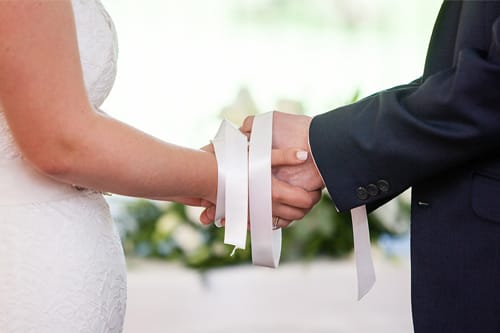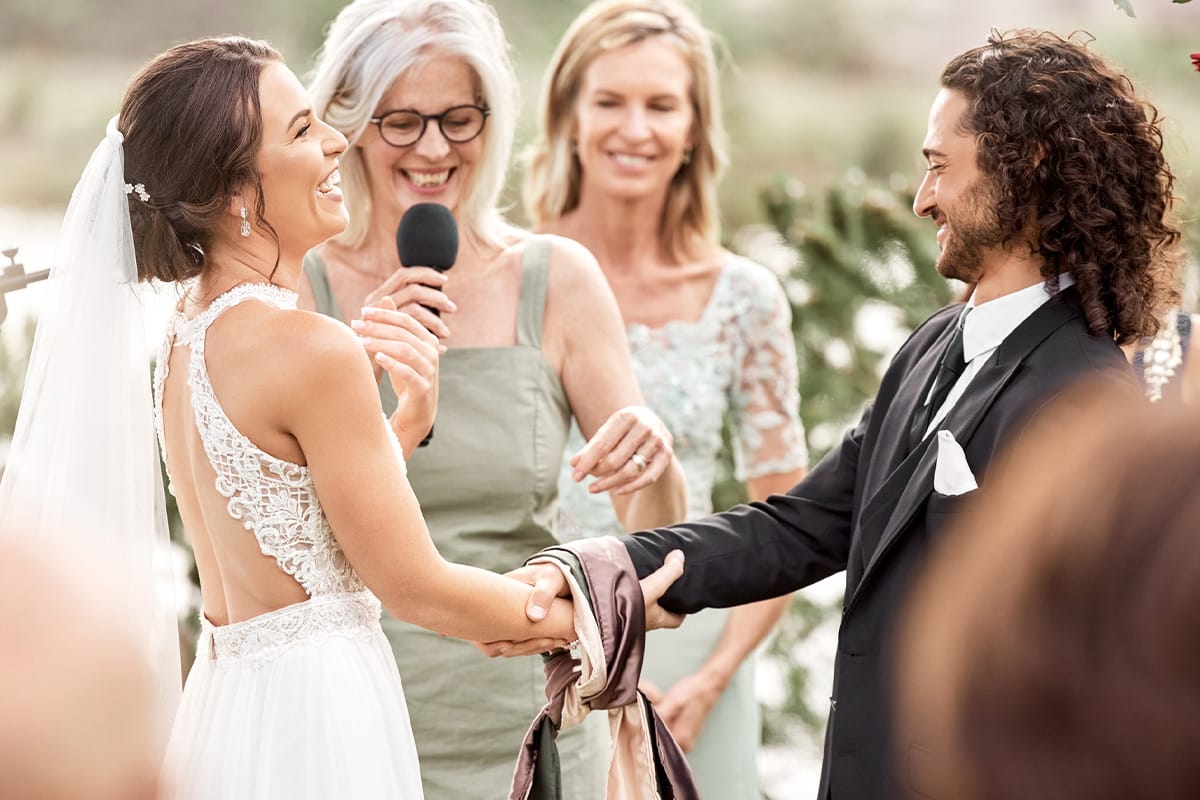
Unity rituals are a nice way to add an extra layer of meaning to a wedding service. Some couples mix together two types of sand into one glass container, others will each take their own candle and use it to light one large candle together. A more popular option would be a handfasting ceremony.
Handfasting is the ancient practice of binding a couple’s hands. Originally this was done during the engagement to make a public declaration of their intent to marry so as to discourage advances from other interested parties. Eventually the binding became a central part of the marriage ceremony itself.
The literal origin of the phrase “tying the knot,” this rite carries great symbolic meaning. While it is most often included in Wiccan and pagan ceremonies, over the decades it has become more mainstream and is even incorporated in weddings for other faith traditions as well as secular nuptials.
As members of an interfaith organization there are many ways ULC ministers can incorporate handfasting into a plethora of wedding styles. It can be both humbling and enlightening to discover how various groups perform this rite. We often hear from many of our officiants that they are eager to learn more about such services.
Historically speaking, handfasting refers to a kind of union originating from the British Isles most likely by the Celts as far back as 7000 B.C. Unlike many traditions, handfasting usually did not involve an officiant, though this is not really the case today as most locations do not allow for self-solemnization.
The distinguishing feature of the service is the linking of the couple’s hands. This can be done by simply clasping the right hand of one partner to the right hand of the other, and vice versa while they face each other.
The crossing of hands symbolizes the joining of all aspects of the couple; left and right, solar and lunar, masculine and feminine. The figure eight shape also stands for the unending commitment to one another.
Handfasting Cord
Fabrics are often incorporated into neo-pagan handfasting ceremonies. These would be wrapped around the couple’s wrists while their hands are clasped in the fashion we mentioned previously. This symbolizes both their bond, and the external support from friends and family in their union.
Cords (ropes) or ribbons are the most commonly used materials for this, but any material that is comfortable and easy to untie afterward will do. To add an extra flourish, you might consider using some of the following in your binding:
- Natural garland
- Vines
- Shells
- Beads
- The couple’s engagement rings
- Heirloom charms or rings
- Family birthstones
- Woven flowers

You’ll likely need a florist for that last suggestion to better ensure the binding holds together.
There are of course places to purchase pre-made bindings such as at craft or fabric stores, as well as the ULC’s ceremonial handfasting cord. If you are braiding your own cord or cutting a strand of existing material, the binding should be a little over one yard in length so that it can be wrapped around the couple’s hands multiple times. The officiating minister would wrap the binding in a figure eight pattern around the couple’s clasped hands either 3, 6, or 9 times. If more than one person is wrapping the materials, one figure eight per person is probably best.For the full effect, couples can remain clasped and tied together until the reception (for safety concerns, we do not recommend remaining bound any longer than that, even if that was the ancient practice). If you brush up on your knowledge of infinity knots, it’s possible that when the couple slips their arms out from the cord, a literal knot will tighten together and remain in the middle, but it’s perfectly fine to just remove the hands and undo the binding.
Modern Sensibilities
We already mentioned that the phrase “tying the knot” references handfasting. We can also see elements of the symbolism when the couple drinks wine from goblets while their arms are interlinked. The notion of duality seen in the crossing of hands is alluded to verbally in the phrase “for better or worse, richer or poorer, in sickness and in health.”
Today it is perfectly common to see handfasting incorporated as part of ceremonies both pagan and non-pagan alike, and in interesting ways. Some couples have taken up the original version of the practice and clasp crossed hands during the engagement.
If a couple has already been legally married, they might want to try a handfasting ceremony as part of their renewal of vows service, or even as part of a wedding anniversary celebration.
Another modern twist on handfasting involves couples having family members fasten the cord around their clasped hands rather than the officiant (assuming the officiant is not related to them). This would be a fresh take on a parent giving away their child at the altar. This would also be a great way for couples with children to make them part of the ceremony, each one making a figure eight with the same binding or perhaps each with their own binding of a different material.
If handfasting sounds like a fun and meaningful ceremony to perform, you can get a free ordination from the Universal Life Church here. We have the tools to equip you in your work, from the ceremonial cord and a handfasting certificate to gift the couple, to a great book for a more in-depth exploration of the topic. We even have a sample handfasting script on how to conduct the service.

